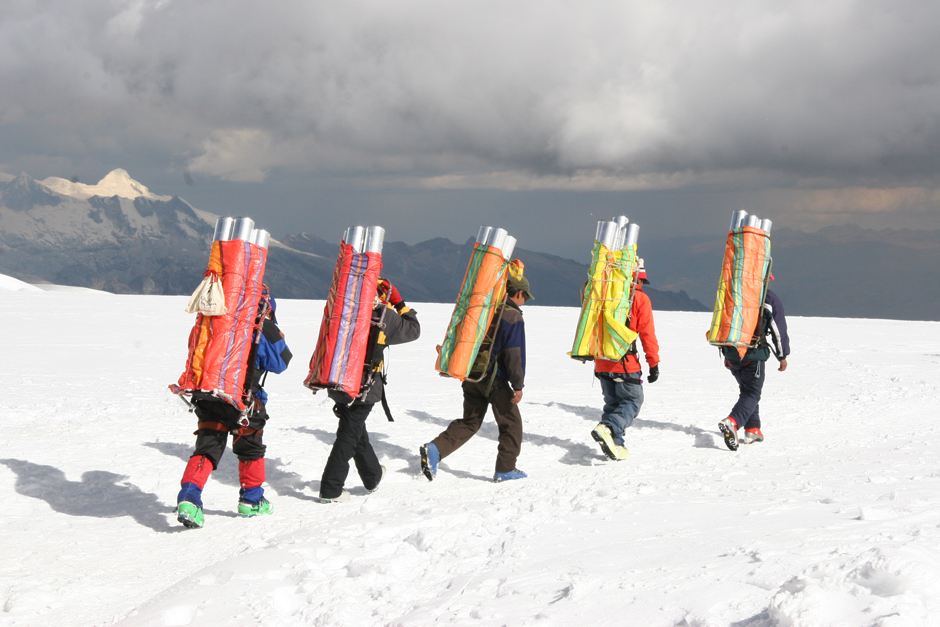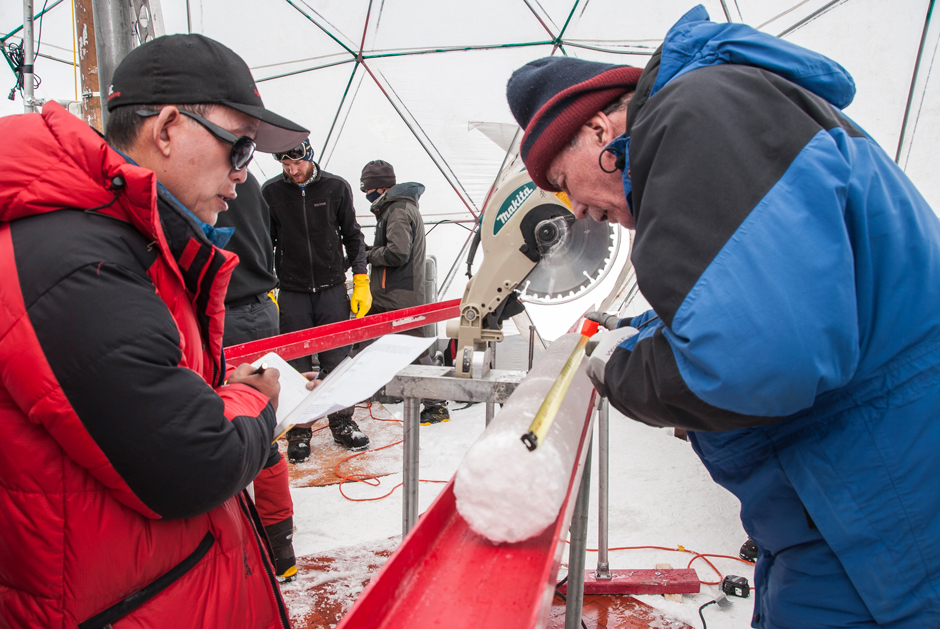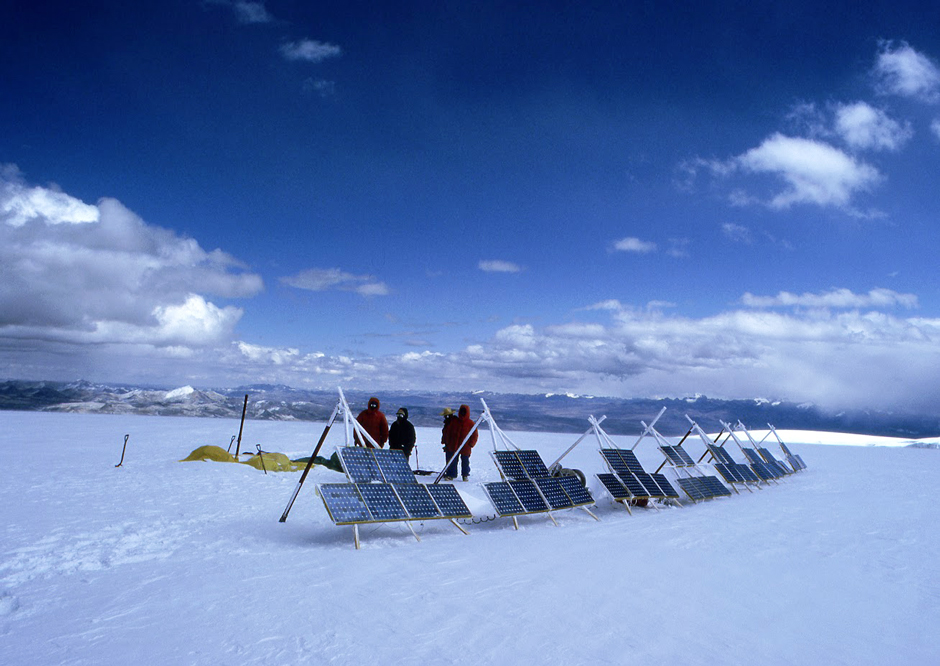Collecting Data at the Top of the World: How Scientists Retrieve Glacial Ice Cores
 Porters must carry the ice cores down from the drill site after the drilling is finished. (Credit: Lonnie Thompson)
Porters must carry the ice cores down from the drill site after the drilling is finished. (Credit: Lonnie Thompson)A helicopter touches down in the small town of Sicuani, Peru, at an elevation of 11,644 feet. Earlier that day, a boxcar brought fuel, drills, food, and other equipment for a glacial expedition. The year is 1979, and glaciologist Lonnie Thompson is preparing to lead a team to the Quelccaya ice cap in hopes of becoming the first scientists to drill an ice core sample from this glacier.
The only problem? The glacier is located at 19,000 feet in one of the most remote areas of the world. The helicopter takes off from the town, but the thin atmosphere at that elevation does not allow it to safely touch down on the ice– due to the aircraft’s weight, and it becomes unstable when the air is less dense. With six tons of equipment needing to be transported and nothing but the backs of scientists to transport it, Thompson is forced to call off the expedition.
With limited funding, little support from other scientists, and uncertainty about the equipment needed to retrieve the ice cores, the prospect of drilling in this part of the world looked grim. However, four years later, Thompson again found himself on the Quelccaya ice cap, this time with a lightweight, solar-powered drill, having retrieved the first-ever ice cores from a tropical glacier.
Expanding the Frontiers of Glaciology
Up until the late 1970s, all of the focus on glacial research took place in the polar regions, primarily in Greenland and Antarctica. The relative ease of access and geographic locations made these glaciers an obvious choice to look into Earth’s history. Yet, being located at the extreme latitudinal ends of the planet meant these glaciers did not capture the entire picture.
However, glaciers in tropical and subtropical regions provided an opportunity to peer into the past of Earth’s climate to a much greater extent. Different factors impacting glaciers in those regions, such as El Niños and monsoons, would provide new insight into glacial movement and the past climate of those regions. Knowing that there was a host of discoveries to be made, Thompson became inspired to push the boundaries of his scientific expeditions.

Thompson (right) and a colleague processing an ice core from the Guliya ice cap in the Western Kunlun Mountains, Tibet. (Credit: Lonnie Thompson)
“It was important to understand both natural variability, what causes climate change in those regions, but then also the human-caused climate changes that are impacting the lives of people living in those regions now,” says Thompson, who is now a distinguished university professor and scholar at Ohio State University. “How do they behave? How do they behave relative to polar glaciers? More focused on glaciological questions.”
After the initial setback in 1979 to reaching the Quelccaya ice cap, Thompson and his team at OSU took it upon themselves to improve the equipment needed to gather data at these altitudes.
To reduce the need for heavy generators and fuel, they installed solar panels on the drills, hoping to eliminate the excess weight. During this time, solar power was still a new concept, but tests on top of an OSU campus parking garage showed that solar generated enough power to drill through ice.
Despite questions about the reliability of solar panels in the early 1980s, they proved capable enough–and light enough–to open up a new frontier in glacial research. Thompson and his team could now expand their research to glaciers around the world that had previously been untouched by science.
Since the first ascent in Peru, Thompson has gone on expeditions to China, Russia, Tanzania, Italy, Bolivia, and Indonesia, all in the pursuit of understanding how the global climate changes.
“To me, what makes these records so unique is the fact that ice cores are probably–no, they are, the best recorders of our past,” Thompson says.
Logistical Challenges in Glacial Expeditions and Collecting Ice Cores
Despite the advances in technology that made tropical glacial expeditions possible, traveling to some of the most remote areas on the planet to gather scientific data still poses a myriad of logistical challenges. However, the challenges associated with drilling and transporting ice cores have not stopped Thompson and his team from gathering information from glaciers around the world.
“Every mountain is a challenge. And you look at it and you have to figure out, ‘okay, how can you accomplish this?” says Thompson.
From using sherpas and local people to help carry the equipment up mountains to loading ice core samples on the back of yaks guided by Tibetan whistlers in the Himalayas, innovation was key in ensuring that the samples would be transported safely from many different parts of the world. Thompson often had to work closely with locals and the government where he was drilling to ensure that the cumbersome but delicate ice cores remained intact.

Thompson and his team developed and used the first solar-powered ice-core drill on top of the Quelccaya Glacier in Peru 1983. (Credit: Lonnie Thompson)
Nearly all of the ice cores Thompson has drilled end up back on the Ohio State campus. Therefore, the process of preserving and transporting the ice cores is always one of the early problems that must be addressed.
While the mountaintops were cold enough for ice, the surrounding areas would melt the ice. The cores had to be inserted into temperature-controlled boxes, which were then carefully transported down the mountains.
Almost immediately after descending the mountain, a freezer needed to be found for the samples until they were transported to a freezer truck and a city where aircraft could be arranged to fly the frozen cores back to the United States. In total, the process of drilling, storing, and transporting frozen ice cores until they arrive back at Ohio State University could take weeks or months.
“The logistics, they never go like you thought it would,” begins Thompson. “So you have to have a good team of people so you can innovate when a problem arises so that you can preserve the core and still get the core back in good shape for analysis. Yeah, it’s a process.”
What Ice Cores Tell Scientists
The challenges in gathering ice cores from tropical glaciers are huge, but what Thompson was learning about the climate system from his expeditions is what drove him to keep going back. Ice cores give a tremendous history of Earth’s climate as they capture information such as temperature, gases, particulate matter, and more that was in the atmosphere through time.
Ice cores are composed of layers, representing the yearly snowfall that is compacted and layered on top of each other as the glacier grows. These layers contain dust particles, chemical aerosols, microbes, isotopes, volcanic ash, black carbon from fires, and pollen. Thompson explains that these particles are often visible in the ice cores and can tell scientists when volcanoes erupted, among other natural phenomena.
Moreover, according to NASA, tiny bubbles of air get trapped as the ice compacts, acting as “tiny bubbles of the atmosphere.” Measuring the chemical makeup of these air bubbles reveals what concentration of these gases was in our atmosphere thousands of years ago. Using these methods, scientists can understand how levels of certain gases, such as greenhouse gases, have changed over time.
Thompson was the first scientist to collect ice cores from the tropics to analyze Earth’s past atmosphere. As he analyzed this data and the isotopic composition of the ice early on, Thompson became one of the first scientists to raise alarm about human-caused climate change. The increased levels of greenhouse gases in the ice from the past century far exceeded the natural variations he observed over the previous thousands of years.
“And so you can really see how big an impact humans are having today, relative to the natural history of this planet. So they’re just wonderful recorders, wherever it is cold enough to preserve an undisturbed record,” Thompson says.

The retreat of the Qori Kalis Glacier is documented in photos taken in the exact spot 45 years apart. (Credit: Lonnie Thompson)
Conclusion
The initial purpose of his expeditions was to learn how tropical glaciers behaved compared to polar glaciers, but repeated expeditions over decades revealed more about the changes happening to Earth’s climate. Having visited the Quelcayya ice cap many times in his career, he was able to photographically capture the melting of glaciers and used the data gathered from ice core analysis to show that Earth’s current warming is outside of natural variability.
“Another part of the story, which we realized later on, is that they’re disappearing,” says Thomson. “Glacial records are not going to be there in the future.”
Ice cores show atmospheric trends that go back hundreds of thousands of years, and comparing those to current records allows scientists to gauge how humans have impacted Earth’s natural cycles. Despite the nature of his discoveries being entrenched in politics and skepticism at times, Thompson knows that the glaciers don’t lie.
“If you stick with the data, and you go with the data–in the end, you win,” says Thompson. “This is about science, geology, physics and chemistry. It doesn’t care what you think, or anyone else thinks.”




0 comments